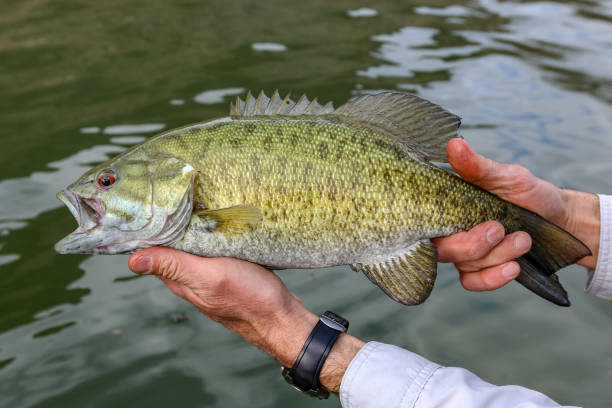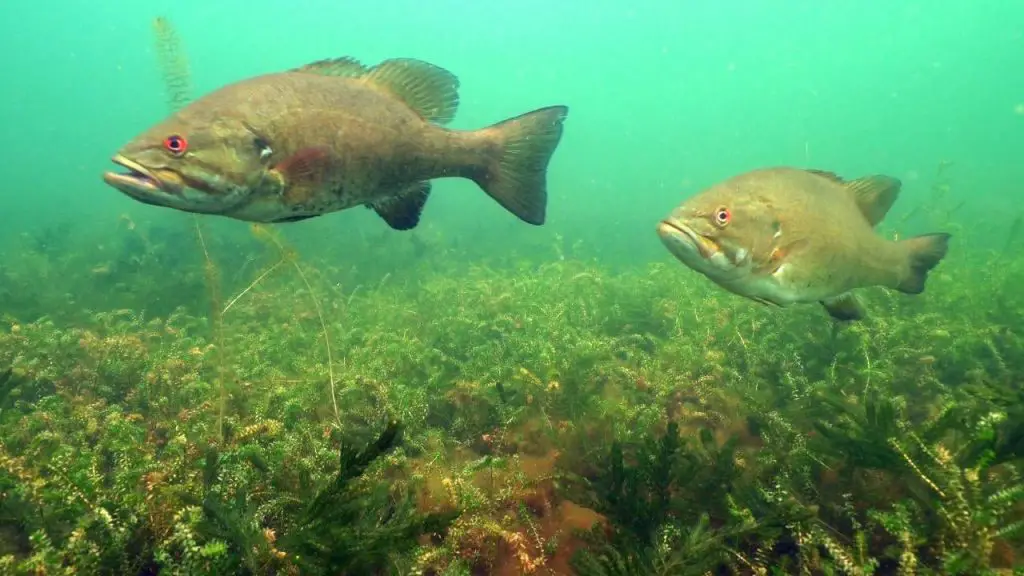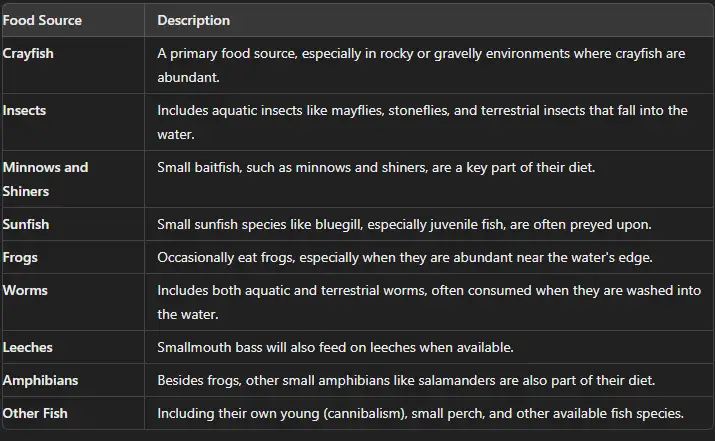Smallmouth bass are one of North America’s most important gamefish. They are famous for their fighting ability when hooked and have the reputation for being, inch-for-inch, the toughest sporting fish around. What Do Smallmouth Bass Eat?
Smallmouth bass are opportunistic predators influenced by H2O temperature that eat whatever live prey is available like:
- Crayfish
- Insects and insect larvae
- Small fish (minnows, shiners)
- Frogs and tadpoles
- Small crustaceans
- Worms and other small invertebrates
- Aquatic plants (rarely)
- Occasionally small mammals
Shiners are a great option for live bait when Smallmouth Bass fishing. These little fish are very lively and will have no problem capturing a Bass’s attention.
Introduction:
Smallmouth bass (Micropterus dolomieu) are freshwater fish native to North America, characterized by their bronze or olive-colored bodies and distinctive dark vertical bands along their sides. These prized sportfish are known for their aggressive strikes and acrobatic fighting style, making them highly sought after by anglers across the continent. Understanding the dietary habits of smallmouth bass is paramount for various reasons.
By unraveling the intricacies of their diet, researchers, anglers, and conservationists can gain valuable insights into the ecological dynamics of freshwater ecosystems. Smallmouth bass plays a crucial role in maintaining the balance of aquatic communities, and their feeding habits directly impact the abundance and distribution of prey species.
Moreover, an in-depth understanding of the smallmouth bass diet is essential for anglers seeking to improve their fishing success. By knowing what smallmouth bass eat, anglers can select appropriate lures, bait, and fishing techniques to target these elusive fish effectively.
Furthermore, the conservation of smallmouth bass populations relies on a comprehensive understanding of their dietary preferences and habitat requirements. By preserving the natural prey base and safeguarding essential habitats, conservation efforts can ensure the long-term sustainability of smallmouth bass populations and the health of freshwater ecosystems as a whole. Thus, delving into the dietary habits of smallmouth bass holds significant implications for both ecological research and resource management practices.

What Do Smallmouth Bass Eat
Smallmouth bass are opportunistic predators that primarily feed on smaller fish such as minnows, shiners, and sunfish. They also consume various aquatic invertebrates including crayfish, insects, and crustaceans. Additionally, smallmouth bass may feed on smaller species of frogs and even small mammals that venture into the water. Their diet can vary depending on prey availability and environmental factors such as water temperature and season. Overall, smallmouth bass are adaptable feeders, capable of consuming a diverse range of prey items within their habitat.
Natural Diet of Smallmouth Bass Fish
A. Overview of Native Habitats
- Smallmouth bass thrive in a variety of freshwater habitats across North America. These habitats typically include clear, cool waters with rocky bottoms, submerged structures like logs and boulders, and ample aquatic vegetation. Smallmouth bass are commonly found in rivers, streams, lakes, and reservoirs, preferring areas with good oxygenation and suitable cover for hunting and shelter.
B. Primary Prey Species
- Invertebrates
- Invertebrates constitute a significant portion of the smallmouth bass diet, especially during their juvenile stages. These include:
- Crayfish: Smallmouth bass are voracious predators of crayfish, which are abundant in rocky habitats. Crayfish provide a high-energy meal rich in protein and essential nutrients.
- Insect Larvae: Smallmouth bass feed on various aquatic insect larvae, including mayflies, caddisflies, and stoneflies, which are prevalent in freshwater environments. These larvae serve as a readily available food source, especially in areas with abundant vegetation.
- Aquatic Insects: Adult insects such as mayflies, dragonflies, and damselflies are also consumed by smallmouth bass when they fall onto the water’s surface, providing opportunistic feeding opportunities.
- Invertebrates constitute a significant portion of the smallmouth bass diet, especially during their juvenile stages. These include:
- Fish
- Smallmouth bass are opportunistic predators and feed on a variety of smaller fish species within their habitats, including:
- Minnows: Small baitfish such as shiners, chubs, and darters are staple prey items for smallmouth bass, particularly in open water areas and along shorelines.
- Sunfish: Juvenile sunfish species like bluegill and pumpkinseed are commonly targeted by smallmouth bass in shallower areas with vegetation cover.
- Perch: Perch species such as yellow perch and white perch are also on the menu for smallmouth bass, especially in areas with rocky structures and deeper waters.
- Smallmouth bass are opportunistic predators and feed on a variety of smaller fish species within their habitats, including:
- Amphibians
- Smallmouth bass opportunistically feeds on amphibians, particularly during warmer months. Amphibians in their diet may include:
- Frogs and Tadpoles: Smallmouth bass prey on frogs and tadpoles found in shoreline areas or shallow waters, especially during breeding seasons when these amphibians are more active.
- Salamanders: Certain salamander species, such as newts and mudpuppies, may also be consumed by smallmouth bass, particularly in habitats with suitable cover and hiding spots.
- Smallmouth bass opportunistically feeds on amphibians, particularly during warmer months. Amphibians in their diet may include:
Understanding the diverse array of prey species consumed by smallmouth bass provides valuable insights into their foraging behavior, ecological role, and interactions within freshwater ecosystems.
- What is the typical habitat of Smallmouth Bass?
- Smallmouth Bass are usually found in clear, cool, and rocky waters, such as rivers, streams, and lakes. They prefer habitats with ample cover like rocks, logs, and submerged vegetation.
- How large do Smallmouth Bass typically grow?
- Smallmouth Bass usually grow to about 12-20 inches in length and can weigh between 1-4 pounds. However, in ideal conditions, they can grow larger, with some individuals reaching up to 7 pounds or more.
- What is the best time of year to fish for Smallmouth Bass?
- The best time to fish for Smallmouth Bass is during the spring and early summer when they are spawning. Fall can also be a productive time as they actively feed to prepare for winter.
- What lures work best for catching Smallmouth Bass?
- Effective lures for Smallmouth Bass include crankbaits, soft plastic worms, jigs, and spinnerbaits. They are particularly attracted to lures that mimic crayfish or baitfish.
- Are Smallmouth Bass aggressive?
- Yes, Smallmouth Bass are known for their aggressive behavior, especially when defending their nests during the spawning season. This makes them a popular target for sport fishing.
- Can Smallmouth Bass be kept in home aquariums?
- While it’s possible, Smallmouth Bass requires a large tank with appropriate filtration and water quality management. They also need a varied diet and ample space to swim.
- What is the difference between Smallmouth Bass and Largemouth Bass?
- Smallmouth Bass have a smaller mouth that does not extend past the eye, a more bronzy coloration with vertical bars, and prefer cooler, clearer waters. Largemouth Bass have a larger mouth, extending beyond the eye, a greenish hue, and prefer warmer, weedy environments.
- What is the best bait to use for Smallmouth Bass?
- Live bait like crayfish, minnows, and nightcrawlers are highly effective. Artificial lures that mimic these prey items also work well.
- How long do Smallmouth Bass live?
- Smallmouth Bass can live for 10-12 years in the wild, though their lifespan can be shorter depending on environmental conditions.
- Are Smallmouth Bass good to eat?
- Yes, Smallmouth Bass are considered good-eating fish with firm, white flesh. However, many anglers practice catch and release, especially for larger fish, to preserve the population.




